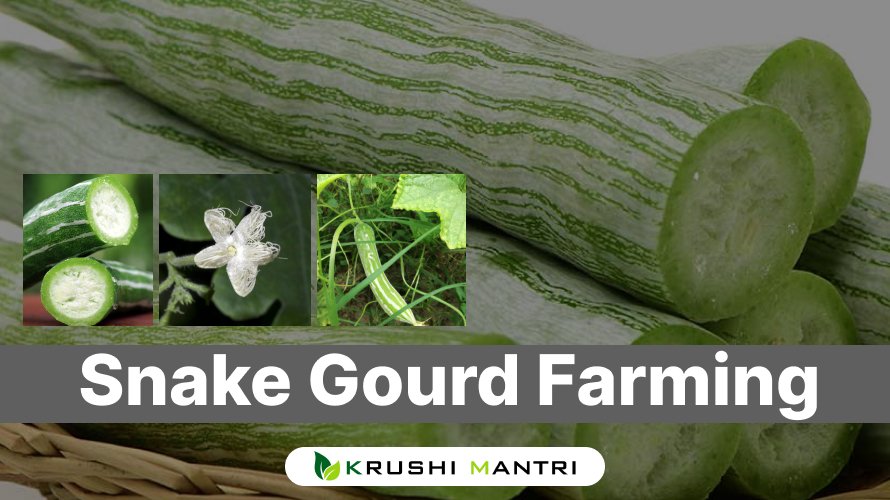Snake gourd (Trichosanthes cucumerina) farming is increasingly becoming a profitable venture for farmers, thanks to its growing demand in both domestic and international markets. Known for its distinctive long, snake-like shape and numerous health benefits, snake gourd is a high-yielding vegetable crop that thrives in tropical and subtropical regions. This post will walk you through everything you need to know about snake gourd farming, from cultivating it successfully to maximizing your earnings.
Why Choose Snake Gourd Farming?
Snake gourd is not just a unique and healthy vegetable; it is also an easy crop to grow and manage. With a relatively short growth cycle and adaptability to a wide range of climates, snake gourd presents an attractive option for farmers looking for a profitable venture. Moreover, its demand in both local and international markets adds to its commercial value.
Benefits of Snake Gourd Farming:
- Low Input Costs: Snake gourd farming does not require a heavy initial investment, making it affordable for small and medium-scale farmers.
- High Yield Potential: With proper care, a single acre can produce a substantial amount of snake gourds, providing a good return on investment.
- Growing Demand: As people are becoming more health-conscious, the demand for vegetables like snake gourd, known for its nutritional benefits, is increasing.
- Versatile Market: Snake gourd can be sold fresh in local markets or exported to international markets. It is also used in the production of herbal medicines and cosmetics.
Snake Gourd Farming Tips
Successful snake gourd farming depends on following the right techniques and practices throughout the planting, growing, and harvesting phases.
1. Climate and Soil Requirements
Snake gourd thrives in warm, tropical climates with a temperature range of 25°C to 35°C. The plant prefers plenty of sunlight and is typically grown during the summer and rainy seasons in India. As for soil, snake gourd performs best in well-drained loamy or sandy-loam soil, with a neutral pH level (6.0 to 7.0). It’s important to ensure that the soil is rich in organic matter.
Tip: Before planting, test the soil’s pH level and adjust accordingly using lime or organic matter to achieve the best growing conditions.
2. Seed Selection and Sowing
Choosing high-quality seeds is critical to ensure a good harvest. The seeds should be soaked in water for about 12-24 hours before sowing to enhance germination. Snake gourd is typically grown from seeds, and sowing is done directly into the field.
- Seed Rate: About 1-2 kg of seeds are sufficient for sowing in one acre.
- Spacing: The seeds should be sown 3-4 inches deep in rows spaced 1.5 to 2 meters apart, with plants spaced 1 meter apart.


Tip: For better germination, sow seeds during the early monsoon season when the temperature and humidity levels are optimal.
3. Irrigation and Watering
Snake gourd requires consistent watering to ensure healthy growth, especially during the dry season. However, care should be taken to avoid waterlogging, which can lead to root rot and fungal diseases.
- Frequency: Water the plants twice a week during the early stages and increase the frequency during the fruiting stage.
- Drip Irrigation: For efficient water use and better yields, adopt drip irrigation systems, which ensure that the plants get sufficient moisture without the risk of waterlogging.
Tip: Watering should be reduced once the fruits start maturing to prevent cracking of the gourds.
4. Training and Pruning
Since snake gourd is a climbing vine, it requires support to grow vertically. Farmers often use bamboo stakes, wires, or trellises to support the vines. Proper training and pruning are essential for better air circulation and sunlight exposure, which promotes healthier growth and larger fruit.
- Trellising: Erect a strong trellis structure to guide the vines and help the plant spread evenly.
- Pruning: Regularly prune the side shoots and weak branches to concentrate the plant’s energy on fruit production.
5. Fertilization and Pest Control
Apply a balanced dose of organic manure or compost before planting to enrich the soil with essential nutrients. Snake gourd also responds well to nitrogen-rich fertilizers during the vegetative stage. Follow it up with phosphorus and potassium fertilizers during the fruiting stage.
Common Fertilizer Application:
- Organic Manure: 15-20 tons per acre
- NPK (Nitrogen, Phosphorus, Potassium): Apply at a ratio of 60:40:40 kg per acre
Tip: Use neem oil or other organic pesticides to control common pests like aphids, fruit flies, and caterpillars. Proper crop rotation and pest management practices can also reduce the risk of pest infestations.
6. Harvesting
Snake gourd reaches maturity in 60-70 days after planting. The fruits are typically harvested when they are still tender and green, as overripe gourds tend to become bitter and lose their texture.
- Harvest Frequency: Snake gourd is a high-yielding plant, and harvesting can be done every 3-4 days once the plants start fruiting.
- Harvesting Technique: Use a sharp knife to cut the fruits carefully from the vines, avoiding damage to the plant and nearby fruits.
Earning Potential from Snake Gourd Farming

The earning potential from snake gourd farming is promising, especially for small and medium-scale farmers. With proper planning and execution, the returns from snake gourd farming can be quite attractive.
Yield per Acre:
Under optimal conditions, snake gourd can produce an average yield of 10 to 15 tons per acre. This yield can vary depending on factors like soil quality, climate, and farming practices.
Market Price:
The price of snake gourd fluctuates depending on location, season, and market demand. On average, snake gourd fetches a market price ranging from ₹15 to ₹40 per kilogram in Indian markets.
- Gross Income: If the market price is ₹25 per kilogram and the yield is 12 tons per acre, the gross income would be ₹3,00,000 per acre.
- Net Income: After deducting input costs (seeds, labor, irrigation, fertilizers, etc.), which generally amount to around ₹1,00,000 per acre, the net income can range between ₹1,50,000 to ₹2,00,000 per acre.
Factors Influencing Profit:
- Market Demand: Demand for snake gourd tends to peak during the summer season, increasing the chances of fetching a higher price.
- Export Market: Exporting snake gourd to international markets, especially to countries with a significant South Asian population, can provide an additional source of revenue.
Tip: To maximize profits, farmers can focus on producing high-quality organic snake gourds, which fetch a premium price in niche markets.
Challenges in Snake Gourd Farming
While snake gourd farming can be lucrative, there are some challenges that farmers should be aware of:
- Pest and Disease Control: Aphids, fruit flies, and fungal infections can impact the crop yield. Regular monitoring and preventive measures like organic pesticides and crop rotation can mitigate these risks.
- Water Management: Over-watering or water scarcity can both harm the plant. Farmers need to ensure proper irrigation practices to maintain consistent water supply without waterlogging.
- Market Fluctuations: Prices can be unpredictable depending on supply and demand. Diversifying the sales channels, such as direct selling, organic markets, or export, can help farmers secure better prices.
- Labor-Intensive: Training vines, pruning, and regular harvesting are labor-intensive processes, requiring significant time and effort.
Conclusion
Snake gourd farming is a viable and profitable option for farmers looking for a high-yielding, low-input crop. With the right techniques, from choosing the best seeds to efficient irrigation and pest control, snake gourd farming can offer significant returns. Additionally, the growing demand for healthy, organic vegetables in local and international markets provides an excellent opportunity for farmers to boost their income. With proper planning and market awareness, snake gourd farming can be a rewarding agricultural venture.
For those looking to diversify their farming activities or start a vegetable farming business, snake gourd is an excellent choice that offers both financial rewards and a sustainable farming experience.









